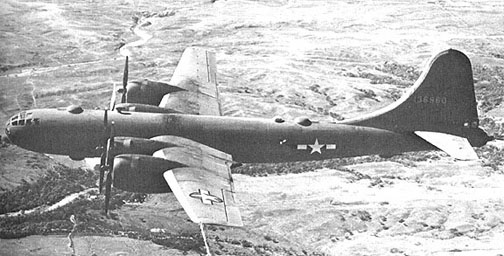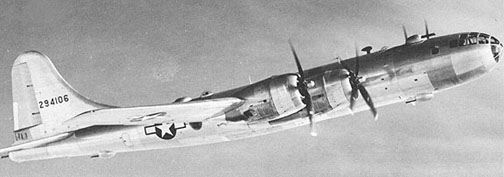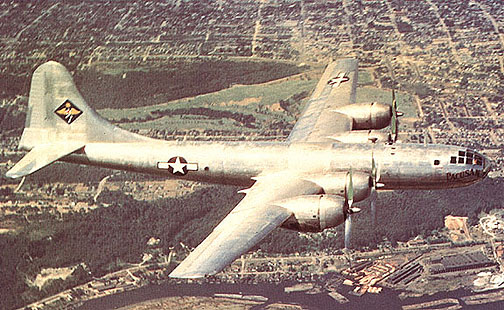Boeing B-29 Superfortress History
Design of the Boeing B-29 Superfortress began well before America’s entry into World War Two, when the Boeing 345 was evolved to a United States Army Air Corps (USAAC) requirement of February 1940 for a “hemisphere defense weapon”. Actually, the US Army began thinking of a “super-bomber” capable of carrying a 2,000+ lbs. bombload over a 5,000+ miles range at a speed of 400+ mph. and at an altitude of 30,000+ ft at the end of the thirties, while the development of the B-17 was still underway. By then it was already clear that airpower would grab the lion’s share in the next war and that only a super bomber could hope to overcome the newer monoplane fighters which seemed to beat new speed records every day. The requirements were submitted to the builders under the “BLR” (bomber-long-range) codename. In 1940, Boeing, Consolidated, Douglas, and Lockheed accepted the challenge and 4 designs were proposed to the Army.
In 1940, Boeing, Consolidated, Douglas, and Lockheed accepted the challenge and 4 designs were proposed to the Army. Douglas’ design was the XB-31, which was rejected and never went past the drawing board. Wind tunnel model of Lockheed’s XB-30. Note similarity with the Constellation Lockheed proposed a very innovative design, the XB-30, which was a military version of a super airliner. It was rejected as a bomber but it eventually became the famous “Constellation”, the most successful propeller airliner ever. Two proposals remained in competition: Consolidated with their XB-32 and Boeing with their Model 341 which later became the XB-29.
In August 1940, the two prototypes designated XB-29, were ordered by the United States Army Air Forces (USAAF), and the first one was flown on 21 September 1942. It was a much larger airplane than Boeing’s earlier B-17 Fortress and was characterized by its circular-section, pressurized fuselage, and remote-controlled gun turrets. The powerplant was four 2,200 hp Wright R-3350-13 Cyclone radial engines. By the time of the first flight, nearly seventeen hundred B-29s had been ordered.
The XB-32 reached the production stage as the B-32 “Dominator” and 116 machines rolled out the Consolidated plant. Even though the Boeing design was clearly the winner, the Army kept the B-32 alive in case the B-29 developed production problems. Although faster than the B-29, the B-32 had far more problems and eventually, the program was scrapped.
Among the four competitors, Boeing had clearly more experience with long-range bombers and their B-17 was already the “standard” USAAF bomber. Before the 341 which won Boeing the air force approval, they had gone through innumerable designs (like the XB-19) which contributed to give them a leg up on the competition.
Boeing Model 341 was very similar to the final B-29 design, except for the absence of the “greenhouse” canopy and the smaller dimensions. The airplane featured great innovations such as pressurized compartments, self-sealing tanks, remote-controlled machine guns, headless (flush) rivets, welded panels, etc. But it turned out to be too small to meet the requirements and it led to the Model 345. In late 1940, the Army ordered three prototypes but before they were readied, in the spring of 1941, the Army Air Corps placed an order for fourteen YB-29s test aircraft and 250 production machines. By now the new bomber had already been nicknamed “Superfortress”. After the Pearl Harbor raid, the production requirement was quickly raised to 500 units.
On September 21, 1942, Boeing unveiled the first prototype. Four 28-cylinder, 2,200 HP Wright R-3350-13 “Cyclone” engines powered the aircraft, the most powerful power plant ever mounted on an airplane by then. Initial specs were 368 mph max speed with a maximum range of 5,900 miles and a service ceiling of 32,000 ft.
The prototype lived up to the high expectations but soon engine problems would start to develop and plague the B-29 program for almost all its production life. The first hint came when on February 18, 1943, the second prototype crashed after the engines caught fire, killing test pilot Eddie Allen, its crew and a dozen people in a meat-packing building.
As a result of the crash, USAAF took direct control of the project in order to speed things up and solve the problems as quickly as possible. Brigadier General Kenneth Wolfe was nominated program director.
On April 15, 1943, the first YB-29 rolled out the Wichita, KS plant with full armament. A total of fourteen machines were produced and tested, still with three-bladed propellers. The first pre-production YB-29 Superfortress flew on 26 June 1943, and squadron deliveries began in the following month to the 58th Bombardment Wing. On October 7, 1943, the first production B-29 was delivered from the Wichita plant.
The first operational Boeing B-29 Superfortress mission was carried out on 5 June 1944, and the first attack upon a target in Japan on 15 June 1944. It was during this month that the Superfortress moved to the bases in the Marianas Islands, from whence they subsequently mounted a steadily increasing bombing campaign against the Japanese homeland. Apart from the direct damage caused by this campaign, it was responsible for many Japanese aircraft from other Pacific battlefronts being for home defense duties, although comparatively few types were capable of indulging in effective combat at the altitudes flown by the American Bombers.
Surperfortresses also carried out extensive minelaying in Japanese waters; a hundred and eighteen others became F-13/F-13A photo-reconnaissance aircraft. Finally, two Boeing B-29 Superfortress bombers brought the war to its dramatic close with the dropping of atomic bombs on Hiroshima and Nagasaki on 6 and 9 August 1945. Each of these atomic bombs with a yield of some 20,000 tons of TNT, totally destroyed the cities instantly. Japan voted to surrender unconditionally only hours after the Nagasaki attack but did not officially make it known to its people until 14 August.
Following the end of World War, Two many of the B-29s were sent to vast storage bases to await their fate; a few were cut up for scrap, while others stayed on active duty with the US Air Force. The backbone of the Strategic Air Command’s equipment into the 1950s would be the Boeing B-29 Superfortress until Consolidated B-36 Peacemakers and Boeing B-47 Stratofortresses became available. At that time, the remaining B-29s sent to the reclamation areas to be cut up for scrap. But a ‘small war’ in a place named Korea put a halt to the B-29s being cut up for scrap. For three long years, beginning in late June 1950, B-29s from Kadena, Okinawa, and Yokota, Japan, were again involved in a conflict in the skies of Asia, hitting targets in North Korea.
B-29 Variants
B-29

The B-29 was essentially similar to the fourteen YB-29’s test aircraft, except for the four-bladed Hamilton-Standard propellers. Other changes involved the substitution of the Sperry turrets with the new General Electric models with computerized gunsights. The engines fitted were a newer version of the Cyclone, R-3350-23. In later bombers, an even newer model was fitted: R-3350-41. The first machines were painted in olive drab over neutral gray but eventually, in order to save weight and production time, they were left unfinished in bare metal.
Three manufacturing plants produced B-29s: Boeing at Wichita KS (1620 bombers), Bell at Marietta GA (357 bombers) and Martin at Omaha NE (204 bombers.)
B-29A

The three plants could not meet USAAF requirement and Boeing added the Renton, WA facility to provide more machines to the war effort. This was a plant traditionally dedicated to the construction of aircraft for the Navy and therefore serial numbers carried the suffix “BN”.
B-29A’s where externally similar to B-29’s, however, some important innovations were introduced. First of all the upper forward turret was for the first time fitted with four .50-cal. machine guns instead of the regular two. But the most important innovation was in the construction of the bomber. On B-29’s the wing center section was made up of two sections bolted together. The Renton facility introduced the one-piece wing center section which simplified construction and strengthened considerably the wing structure. In addition, the B-29A mounted an improved version of the Cyclone engine: R-3350-57.
A total of 1,119 B-29A’s were built at Renton.
B-29B

the longest non-stop flight from Honululu to cairo, Egypt in 39 hours.
After the first high-altitude raids on Japan, it quickly became clear that enemy fighter defense was far less effective than anticipated and Gen. Curtiss LeMay decided that new bombing tactics called for a low-level bombing at night. Besides, a gap in the Japanese AA gun defense was discovered at an altitude where heavy AA guns were almost ineffective and light AA machine-guns were at the practical limit of their range. A lighter and faster B-29 would be ideal for this kind of mission and the Marietta, GA plant started to build B-29B’s to meet the new requirements.
The B-29B mounted a powered-up version of the Cyclone engine, with a new engine coolant system which, coupled with a better aerodynamic profile and the weight reduction, gave the bomber roughly a 30 mph. advantage over older versions. And in order to achieve better aerodynamics and reduce the overall weight, all turrets were landed and the aircraft was left only with the two .50-cal machine guns in the tail. By the time B-29B’s entered service, Iwo Jima was already in US hands and P-51D fighters became available as escorts for the entire mission over Japan. However, an experimental fire control radar (AN/APQ-15) housed in an external radome beneath the machine-guns was introduced with the B-29B and proved moderately effective, especially at short ranges.
Operational History
World War II
The B-29 Superfortress was the most technologically advanced bomber of World War II. The first combat operations for the Superfortress began with the raid on Bangkok on June 5th, 1944. It turned out that the B-29 was the only long-range bomber able to reach and bomb Japan and return safely. It was quickly learned that the B-29 was a real winner.
During wartime, the B-29 Superfortress flew at altitudes of 40,000 feet at speeds of 350 mph. What was so great about that was the Japanese fighters could barely reach altitudes like that and once there had a real tough time catching the fast Superfortress. Hitting one with the heaviest of anti-aircraft weapons was next to impossible because at the time the Axis forces did not have proximity fuses.
Early in 1945, the role changed from a high altitude day bomber to a low altitude night bomber. The defensive armament was removed to carry greater fuel and bomb loads.
For the first time in history, crews enjoyed a fully pressurized cabin in the bomber. A long tunnel spanned over the two bomb bays to the tail section allowing the crew to crawl back and forth. This leaving the bomb bays un-pressurized eliminating the need to depressurize them for the bombing.
The most famous of the B-29’s in the well known “Enola Gay”, which dropped the first atomic bomb used in wartime. The atomic bomb known as “Little Boy” was dropped on Hiroshima on August 6th, 1945. Another B-29 called “Bockscar” dropped the second atomic bomb on Nagasaki three days later. It was these actions along with the Soviet invasion of Manchuria on August 9th of 1945 that cause the Japanese to surrender and the official end of World War II.
The Soviet Copy
Individual B-29s made several emergency landings in Soviet territory during 1944, after bombing raids on Japanese Manchuria and Japan. The Soviets interned and kept the bombers in accordance with Soviet neutrality in the Pacific War. The Tupolev OKB dismantled and studied them, despite American requests for their return. Soon afterward, Tupolev and his design bureau received from Stalin the order to copy the B-29s down to their smallest details, and produce as soon as possible a design ready for quantity production.
The Soviets debuted in 1947 both the Tupolev Tu-70 transport variant and the Tupolev Tu-4 “Bull” copy of the B-29. Many later bombers and transports would have incorporated tail-gunner positions similar to the B-29.
Boeing B-29 Superfortress Specifications
| Aircraft Type: |
| bomber |
| Dimensions: |
| wingspan: 141 ft, 3 in |
| length: 99 ft |
| height: 29 ft, 7 in |
| Weights: |
| empty: 74,500 lb |
| gross: 135,000 lb |
| Power plant: |
| 4 × 2,200 hp Wright Cyclone R-3350 turbocharged radial engines |
| Performance: |
| maximum speed: 358 mph |
| ceiling: 31,850 ft |
| maximum range: 3,250 mi |
| Armament: |
| 12 × 0.50 in caliber machine guns |
| 20,000 lb of bombs |
| Service dates: |
| 1944–1954 |









